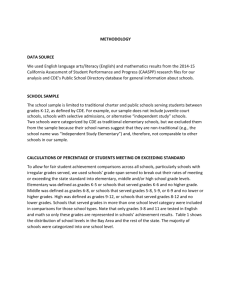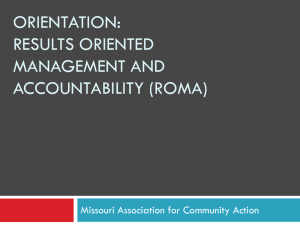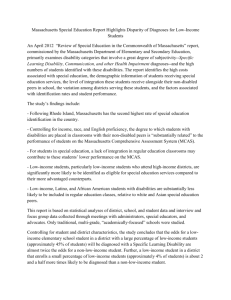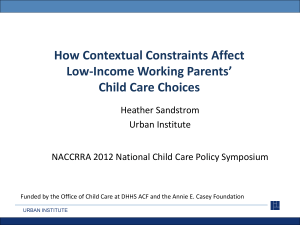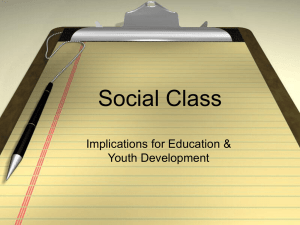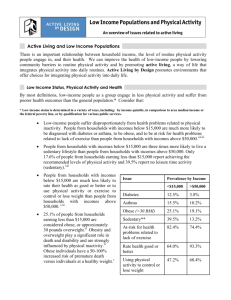a grant proposal by - California State University, Long Beach
advertisement
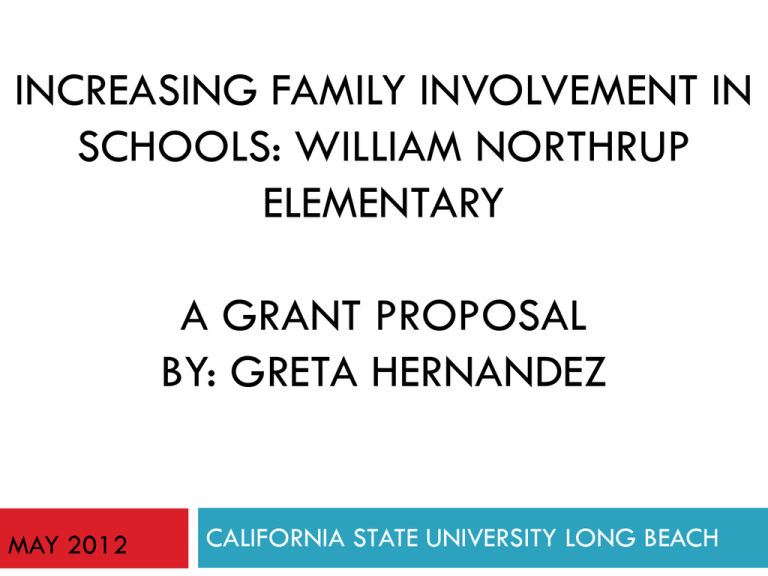
INCREASING FAMILY INVOLVEMENT IN SCHOOLS: WILLIAM NORTHRUP ELEMENTARY A GRANT PROPOSAL BY: GRETA HERNANDEZ MAY 2012 CALIFORNIA STATE UNIVERSITY LONG BEACH INTRODUCTION The purpose of this project was to design a family involvement program, to identify potential funding sources, and to complete a grant application to fund the program for William Northrup Elementary. Research strongly indicates that children who come from low-income families and communities are more likely to face a variety of challenges, which can negatively affect their academic achievement (Cooper, Crosnoe, Suizzo, & Pituch, 2010). Although the benefits of family involvement are many, low-income and families of color often face a multitude of barriers that make it difficult to be actively involved in their children’s education (Alameda-Lawson, et al., 2010; Turney & Kao, 2009). Social Work Relevance •Considering the various positive effects of family involvement, it is important to utilize social work knowledge and skills to promote family involvement (Cheung & Pomerantz, 2011; El-Nokali, et al., 2010; Semke, et al., 2010; Wilson, et al. 2011). •Social work knowledge and skills are ideal for serving as the broker between schools and families in order to educate, advocate, and help build understanding among diverse students, families and schools (Cheung & Pomerantz, 2011; El-Nokali, et al., 2010; Semke, et al., 2010; Wilson, et al. 2011). •The implementation of family involvement programs with the outreach efforts done by social workers should help improve the lives of students, families and the overall school environment. Cross Cultural Relevance The conditions of a child’s home and school life can greatly affect his/her educational outcomes (Gleason & Dynarski, 2004). •Factors such as neighborhood poverty and family stress often faced by lower income and minority families contributed to the achievement gap among lowerincome and middle-class students as well as between ethnic groups (Berliner, 2009). •English language learners may experience more academic challenges and are more likely to attend public schools that have low standardized test scores (Simon, et al., 2011). •Educational family involvement has a buffer effect on children’s education, across race and socioeconomic status. Therefore, family involvement programs that target low-income, culturally diverse families are of tremendous value to the diverse communities. Methods Target population The target population was parents of William Northrup Elementary, a kindergarten through 8th grade school and part of the Alhambra Unified School District. The student population is predominantly Latino (55%) and Asian/Pacific Islander (41 %) (California Department of Education, 2010). Eighty one percent of the children are eligible for free or reduced lunch meals and 47% are English Language Learners. Strategies used to identify and select a funding source The grant writer explored opportunities at the federal, state and foundation levels. Internet searches were utilized as well as a thorough foundation search at La Pintoresca library. Search terms entered in the grant search were parent involvement, family involvement, education, parent education, parent engagement, low-income, parent empowerment, family services, early childhood education, drop-out prevention and family resources and services Methods Continued… Funding Source The Joseph Drown foundation was chosen because its primary focus is in supporting educational programs in the Los Angeles area that aim to resolve existing problems in public or private K12th schools. Other areas of interest include, community, health and social services, medical and scientific research, and arts and humanities. Sources for Needs Assessment The California Department of Education website provided the Academic Performance Index (API) scores, the California Standards Test Scores, truancy rate, suspensions and expulsions among students as well as the ethnic make-up of the teachers. Additionally, information was gathered through discussions with William Northrup staff and written school materials. Projected Budget Range and Categories The budget will cover the personnel required to run the program, including the social worker, family engagement worker and child care workers. The budget will also cover program supplies, equipment, printing, food supply, travel expense, participant incentives and administration. The projected budget range for the first year is $139,406.00. Grant Proposal Program Summary and Description The purpose of the family involvement program is to improve children’s academic achievement, increase family participation, and improve parent-teacher relationships. The program components will include outreach efforts, parent education classes, teacher training and family friendly events. The yearlong program will provide services to the families, staff and students enrolled in kindergarten through third grade. Population Served Families in the primary grades will be targeted since research suggests that early academic success and school attendance are linked to positive outcomes (Cooper et al., 2010; Sheppard, 2009). Grant Proposal Continued… Program Objectives The objectives of the program are to: A. Increase the number of parents involved in their children’s education by 30%. B. Significantly increase parent knowledge and skills about the educational system and how to support their children’s education by providing weekly workshops. C. Create better relationships between teachers and families by increasing parent teacher interaction. D. Improve teacher’s ability to communicate with and engage parents by providing monthly teacher development workshops. Program Evaluation Program effectiveness will be evaluated by the social worker. Parents and caregivers will complete family involvement surveys at the time they enter the program and at the end of the year. Family involvement will be measured from sign-in sheets for the workshops and socials. Additionally, report cards and test scores of children will be compared to those children that did not participate. Similarly, teacher surveys will be given out before and after the teacher development workshops to explore changes in their interactions with and perceptions of family involvement. Discussion Lessons Learned Implications for Social Work It was necessary to identify the needs of the school as well as existing programs. The literature review was instrumental in helping the writer frame the purpose, objectives and strategies for the program. Grant writing is a process that takes time, revisions, commitment, patience and knowledge. The grant must be written in a way that engages and persuades. The grants objectives must be clear, concise and measurable. The grant writer found that budgeting required meticulous planning and consideration. For instance, every detail and expense had to be accounted for and justified thoroughly in the budget narrative. Unfortunately, public institutions like schools are often the first to suffer budget cuts that directly impact the entire community. Given the comprehensive and lasting effects of family involvement, social workers should be at the forefront designing programs that target low-income and culturally diverse families in order to promote family involvement in a school setting. It is important that social workers advocate, educate and inform about the various benefits that family involvement programs provide to families, schools and students. Grant writing, program design and program implementation are skills that are beneficial for social workers. Securing funding through grant writing is a more effective outlet to address the References Alameda-Lawson, T., Lawson, M. A., & Lawson, H. A. (2010). Social workers’ roles in facilitating the collective involvement of low-income, culturally diverse parents in an elementary school. Children & Schools, 32, 172-182. Berliner, C. (2009). Poverty and potential: Out-of-school factors and school success. Boulder and Tempe: Education and the public interest center & education policy research unit. Retrieved December 21, 2011 fromhttp://epicpolicy.orgpublication/poverty-and-potential California Department of Education. (2010a). School demographic characteristics. Retrieved March 8, 2012, from http://dq.cde.ca.gov/dataquest/Acnt2011/ 2010 BaseSchDC.aspx?allcds=19-75713-6011118&c=R Cheung, C., & Pomerantz, E. M. (2011). Parents’ involvement in children’s learning in the United States and China: Implications for children’s academic and emotional adjustment. Child Development, 82, 932-950. Cooper, C. E., Crosnoe, R., Suizzo, M., & Pituch, K. A. (2010). Poverty, race, and parental involvement during the transition to elementary school. Journal of Family Issues, 31, 859-883. El Nokali, N. E., Bachman, H. J., & Votruba-Drzal, E. (2010). Parent involvement and children’s academic and social development in elementary school. Child Development, 81, 988-1005. Semke, C. A., Garbacz, S., Kwon, K., Sheridan, S. M., & Woods, K. E. (2010). Family involvement for children with disruptive behaviors: The role of parenting stress and motivational beliefs. Journal of School Psychology, 48, 293-312. Sheppard, A. (2009). School attendance and attainment: Poor attenders' perceptions of schoolwork and Parental involvement in their education. British Journal Of Special Education, 36, 104-111. Simon, C., Lewis, S., Uro, G., Uzzell, R., Palacios, M., & Casserly, M., (2011). Today's promise, tomorrow's future: The social and educational factors contributing to the outcomes of Hispanics in urban schools. Council Of The Great City Schools. Retrieved from http://www.eric.ed.gov/contentdelivery/servlet/ERICServlet? accno=ED526965 Turney, K., & Kao, G. (2009). Barriers to school involvement: Are immigrant parents disadvantaged? Journal Of Educational Research, 102, 257-271. Wilson, S., Tanner-Smith, E., Lipsey, M. W. (2011). Dropout prevention and intervention programs: Effects on school completion and dropout among school-aged children and youth. Society for Research on Educational Effectiveness. Retrieved from http://www.eric.ed.gov/contentdelivery/servlet/ERICServlet? accno=ED519121
